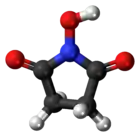N-Hydroxysuccinimide
N-Hydroxysuccinimide (NHS) is an organic compound with the formula (CH2CO)2NOH. It is a white solid that is used as a reagent for preparing active esters in peptide synthesis. It can be synthesized by heating succinic anhydride with hydroxylamine or hydroxylamine hydrochloride.[2]
| |||
 | |||
| Names | |||
|---|---|---|---|
| Preferred IUPAC name
1-Hydroxypyrrolidine-2,5-dione | |||
| Other names
HOSu, HSI. | |||
| Identifiers | |||
3D model (JSmol) |
|||
| ChemSpider | |||
| ECHA InfoCard | 100.025.456 | ||
PubChem CID |
|||
| UNII | |||
CompTox Dashboard (EPA) |
|||
| |||
| |||
| Properties | |||
| C4H5NO3 | |||
| Molar mass | 115.09 g/mol | ||
| Appearance | Colourless solid | ||
| Melting point | 96.3 °C (205.3 °F; 369.4 K)[1] | ||
| Related compounds | |||
Related imides |
Succinimide N-Bromosuccinimide | ||
Except where otherwise noted, data are given for materials in their standard state (at 25 °C [77 °F], 100 kPa).
Infobox references | |||
Activating reagent
NHS is commonly found in organic chemistry or biochemistry where it is used as an activating reagent for carboxylic acids.[3] Activated acids (carboxylates) can react with amines to form amides for example, whereas a normal carboxylic acid would just form a salt with an amine.
Use
A common way to synthesize an NHS-activated acid is to mix NHS with the desired carboxylic acid and a small amount of an organic base in an anhydrous solvent. A coupling reagent such as dicyclohexylcarbodiimide (DCC) or ethyl(dimethyl aminopropyl) carbodiimide (EDC) is then added to form a highly reactive activated acid intermediate. NHS reacts to create a less labile activated acid. The group is usually written as SuO- or -OSu in chemical notation. Such an ester with acid and NHS, sometimes called succinate ester, is stable enough to be purified and stored at low temperatures in the absence of water and, as such, is commercially available. NHS esters are commonly used for protein modification (e.g. an NHS ester of fluorescein is commercially available, and can be added to a protein to obtain a fluorescently labeled protein in a straightforward reaction and purification step).
NHS can be used with EDC to immobilize enzymes for biosensor applications.[4]
Alternatives
Some alternatives to NHS are the water-soluble analog sulfo-NHS, hydroxybenzotriazole (HOBt), 1-hydroxy-7-azabenzotriazole (HOAt), and pentafluorophenol.
References
- Haynes, William M., ed. (2016). CRC Handbook of Chemistry and Physics (97th ed.). CRC Press. p. 3.316. ISBN 9781498754293.
- Knight, David W. (2001). "N-Hydroxysuccinimide". Encyclopedia of Reagents for Organic Synthesis. doi:10.1002/047084289X.rh069. ISBN 0471936235.
- Anderson, G.W.; Zimmerman, J. F.; Callahan, F. M. (1963). "N-Hydroxysuccinimide Esters in Peptide Synthesis". J. Am. Chem. Soc. 85 (19): 3039. doi:10.1021/ja00902a047.
- Camargo, Jéssica Rocha; Baccarin, Marina; Raymundo-Pereira, Paulo A.; Campos, Anderson M.; Oliveira, Geiser G.; Fatibello-Filho, Orlando; Oliveira, Osvaldo N.; Janegitz, Bruno C. (2018-11-30). "Electrochemical biosensor made with tyrosinase immobilized in a matrix of nanodiamonds and potato starch for detecting phenolic compounds". Analytica Chimica Acta. 1034: 137–143. doi:10.1016/j.aca.2018.06.001. PMID 30193627. S2CID 52174400.

